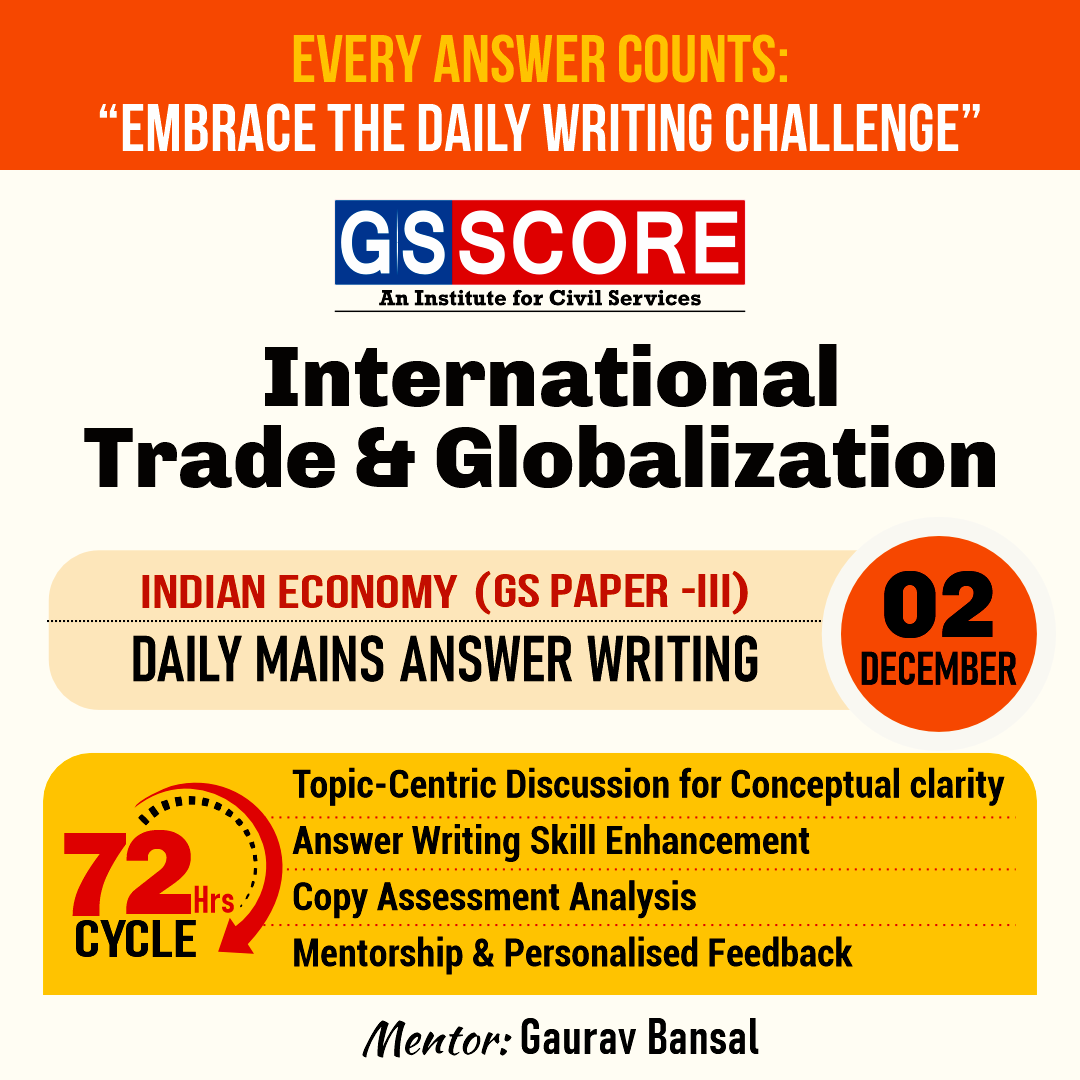


Instruction:
- There will be 2 questions carrying the First Question is-10 marks Write your answers in 150 words and the Second Question is-15 marks Write your answers in 250 words.
- Any page left blank in the answer-book must be crossed out clearly.
- Evaluated Copy will be re-uploaded on the same thread after 2 days of uploading the copy.
- Discussion of the question and one to one answer improvement session of evaluated copies will be conducted through Google Meet with concerned faculty. You will be informed via mail or SMS for the discussion.
Question #1. Why is India still an attractive investment destination despite a falling rupee and other impediments? Suggest short term and long term measures that India can take to maintain the FDI inflows. 10 marks (150 words)
Question #2. Analyze the Foreign Trade policy of india in context of diversification of India's Trade Basket and Trade partners? What are benefits of such diversity and how we can achieve it? 15 marks (250 words)
(Examiner will pay special attention to the candidate's grasp of his/her material, its relevance to the subject chosen, and to his/ her ability to think constructively and to present his/her ideas concisely, logically and effectively).
STEPS & INSTRUCTIONS for uploading the answers
Step 1 - The Question for the day is provided below these instructions. It will be available at 7:00 AM.
Step 2 - Uploading of Answers : Write the answer in A4 Sheet leaving proper margins for comments and feedback and upload the PDF in MY ACCOUNT section. Click on the option of SUBMIT COPY to upload the PDF.
Step 3 - Deadline for Uploading Answers: The students shall upload their answers by 7:00 PM in the evening same day. The first 50 copies will be evaluated.
Step 4 - Feedback : Mentors will give their feedback for the answers uploaded. For more personalised feedback, join our telegram channel by clicking on the link https://t.me/mains_answer_writing_cse . A one-to-one session will be conducted with the faculty after copy evaluation in 72 Hrs.
Model Answer
Question #1. Why is India still an attractive investment destination despite a falling rupee and other impediments? Suggest short term and long term measures that India can take to maintain the FDI inflows. 10 marks (150 words)
India aspires to become a developed and high-income country over the next 25 years. Though the global Covid-19 pandemic, rising inflation, and the ongoing conflict in Ukraine have dented the Indian rupee, India has been able to effectively handle the economic setbacks through fiscal support. According to a report of CII-EY, India has a potential to attract FDI flows of $475 billion in the next five years.
Reasons why India is still an attractive destination despite a falling rupee:
- Enormous Market Potential: India is currently the world’s most populous country which provides enormous potential for market growth. India’s median population age is between 28 and 30 years. India has a young working population that will be a key driver of long-term economic growth in the country.
- Government Support, Reforms and Policies: Global investors are interested in India due to its apparent stability in inflation, fiscal deficit, and growth. Overall, India remains a very appealing destination for investment, with investors appreciating the macroeconomic stability that the government has been willing to impose even in difficult circumstances.
- Low Manufacturing Costs: India has one of the world’s lowest manufacturing costs and scalability. According to a BCG report, India ranks second among world countriesin terms of lowest manufacturing costs.
- Abundant manpower:India has one of the world’s youngest populations, with more than half of the population under the age of 25 and more than 65% under the age of 35. This provides a consistent supply of labour at a low cost. India’s skilled and semi-skilled workforce is a valuable human resource. Labor is cheap, which lowers production costs and increases competitiveness.
- Rapid Business Reforms: The country’s purchasing power is enormous. These elements will undoubtedly entice any investor. Recent reforms have included changes to FDI policy, the implementation of the Goods and Services Tax (GST), and other business-related reforms that have improved the Ease of Doing Business.
- Favourable Industrial Climate:With appealing industrial policies, programmes such as Skill India and Digital India, and significant investments in industrial corridors, seaports, airports, roads, and railways, India provides a favourable investment climate for manufacturing firms.
Measures that India can take to maintain the FDI inflows:
Short term measure to Increase FDI inflows:
- By simplifying incentives and making them automatic for all investors acting within the framework of tax and customs legislation, economies in transition could make their investment climates more attractive.
- By simplify registration procedures, reduce price controls to a minimum, dismantle trade barriers, foster favorable conditions for private sector development,
- By putting an end to bureaucratic interference, strengthen financial institutions and banking supervision, create a commercially oriented infrastructure, and give foreign investors a greater opportunity to participate in privatization.
- Doing better job of marketing, identifying potential foreign investors and providing them with complete information about investment opportunities.
- Provision of guarantees for foreign investments and programs for direct investment in small businesses can help in scaling up investment in a country.
Long term Measures:
- Government policies/decisions: are of crucial importance in creating a conductive environment for global investors. The disruptions induced by the pandemic have given opportunities for India to expand its global footprints.
- The government is striving to strengthen the FDI environment through an array of policy initiatives such as Make in India, Invest India, Investment clearance cell and reforms at all levels.
- This also has to be complemented by a sound trade policy to boost exports further, encourage inclusive development, and incentivize R&D (research & development) to make our industry globally competitive.
- The manufacturing sector and the agriculture sector needs to be hyped in order to bring more FDI into the sectors to create parity among all the three sectors.
- FDIs have more potential to facilitate the growth of the Indian economy than Foreign Portfolio Investment (FPI). It should be ensured that India remains an attractive, safe, predictable destination for serious, long term investors.
- A level playing field is necessary if we want continued foreign investments. Sneaking loyalty towards local players should be avoided.
India's FDI inflows have increased 20 times from 2000-01 to 2021-22, this was mainly due to the government's efforts to improve the ease of doing business and relax FDI norms. Whether it is prioritizing macroeconomic stability by establishing a framework to combat inflation, doing GST reforms, creating a common market, opening new sectors, privatization, or infrastructure development, India has effectively overcome the current challenges with a strong political will.
Question #2. Analyze the Foreign Trade policy of india in context of diversification of India's Trade Basket and Trade partners? What are benefits of such diversity and how we can achieve it? 15 marks (250 words)
The major concern today is reviving India’s exports given the international situation particularly with just 1.9 per cent world trade volume growth in 2023 (the lowest since the 2009 financial crisis) and in the wake of the rising non-tariff measures (NTMs) by different countries.
India’s export basket has included diverse products and is gaining competitiveness in many new categories over time. India’s Foreign Trade Policy (FTP) provides the basic framework of policy and strategy for promoting exports and trade.
The current Foreign Trade Policy focusses on improving India’s market share in existing markets and products as well as exploring new products and new markets. India’s Foreign Trade Policy also envisages helping exporters leverage benefits of GST, closely monitoring export performances, improving ease of trading across borders, increasing realization from India’s agriculture-based exports and promoting exports from MSMEs and labour intensive sectors.
While the external environment has a major role to play in the success of export policies, it is also critical to address constraints within India including infrastructure bottlenecks, high transaction costs, complex procedures, constraints in manufacturing and inadequate diversification in India’s services exports.
Trade Partner Diversification
Post-FY2000, Asian, African and Middle East Nations, such as the UAE, Singapore, Hong Kong, and China, have replaced India’s traditional export partners, such as the UK, Germany, Belgium etc. The share of Europe, which was around 40.9 per cent in India’s merchandise exports in FY92, fell to 19.2 per cent in FY15. The combined share of the developing regions viz. Asia and Africa in India’s total exports rose from around 37.5 per cent in FY92 to 51.4 per cent in FY23.
Way Forward:
More Incentives for Exporters: The new FTP could benefit exporters if the incentives granted to retail and wholesale traders under the ambit of the MSME category are extended to them as well.
The new FTP must enable exporters to leverage technology in the field of foreign trade. This will be particularly beneficial for MSMEs to compete with their global peers.
WTO Compliant Schemes: This should be at the core of the FTP. The WTO works to dissuade governments from heavily subsidising exporters to provide a level playing field to all nations.
The Indian government is well aware of the need to stay within the WTO norms and has already taken significant steps to withdraw subsidy-led schemes.
However, more needs to be done at a fundamental level to promote exports and ensure that Indian exports are competitive in the global market.
Multiple states can also exploit their innate diversity through competitive federalism by promoting products unique to them and helping them reach the global market. Consistent investment in research and development can foster innovation, which in turn can facilitate higher efficiency in exports, and diversification of India’s export basket. Further efforts in identification of new markets and exporting diversified products according to state’s competitive advantage can help India in improving its global footprint.
In future, positive developments in the manufacturing sector, driven by production capacity expansion, government policy support, heightened M&A activity, and PE/VC-led investment, are expected to create a robust pipeline to sustain economic growth in the years to come. These factors will continue to play out during the course of this decade, which will accelerate India’s manufacturing-led exports.


